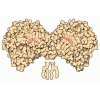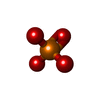[English] 日本語
 Yorodumi
Yorodumi- PDB-3kcf: Crystal structure of TGFbRI complexed with a pyrazolone inhibitor -
+ Open data
Open data
- Basic information
Basic information
| Entry | Database: PDB / ID: 3kcf | ||||||
|---|---|---|---|---|---|---|---|
| Title | Crystal structure of TGFbRI complexed with a pyrazolone inhibitor | ||||||
 Components Components | TGF-beta receptor type-1 | ||||||
 Keywords Keywords | TRANSFERASE / KINASE / TGFBETARI / STRUCTURE-BASED DRUG DESIGN / PROTEIN-INHIBITOR COMPLEX / Aortic aneurysm / ATP-binding / Craniosynostosis / Disease mutation / Disulfide bond / Glycoprotein / Magnesium / Manganese / Membrane / Metal-binding / Nucleotide-binding / Phosphoprotein / Polymorphism / Receptor / Serine/threonine-protein kinase / Transmembrane | ||||||
| Function / homology |  Function and homology information Function and homology informationextracellular structure organization / epicardium morphogenesis / vascular endothelial cell proliferation / parathyroid gland development / transforming growth factor beta ligand-receptor complex / regulation of cardiac muscle cell proliferation / myofibroblast differentiation / positive regulation of epithelial to mesenchymal transition involved in endocardial cushion formation / TGFBR2 Kinase Domain Mutants in Cancer / transforming growth factor beta receptor activity ...extracellular structure organization / epicardium morphogenesis / vascular endothelial cell proliferation / parathyroid gland development / transforming growth factor beta ligand-receptor complex / regulation of cardiac muscle cell proliferation / myofibroblast differentiation / positive regulation of epithelial to mesenchymal transition involved in endocardial cushion formation / TGFBR2 Kinase Domain Mutants in Cancer / transforming growth factor beta receptor activity / trophoblast cell migration / angiogenesis involved in coronary vascular morphogenesis / SMAD2/3 Phosphorylation Motif Mutants in Cancer / TGFBR1 KD Mutants in Cancer / positive regulation of mesenchymal stem cell proliferation / ventricular compact myocardium morphogenesis / positive regulation of extracellular matrix assembly / positive regulation of tight junction disassembly / cardiac epithelial to mesenchymal transition / mesenchymal cell differentiation / TGFBR3 regulates TGF-beta signaling / transforming growth factor beta receptor activity, type I / positive regulation of vasculature development / neuron fate commitment / activin receptor complex / activin receptor activity, type I / regulation of epithelial to mesenchymal transition / type II transforming growth factor beta receptor binding / pharyngeal system development / transmembrane receptor protein serine/threonine kinase activity / receptor protein serine/threonine kinase / activin binding / TGFBR1 LBD Mutants in Cancer / germ cell migration / filopodium assembly / coronary artery morphogenesis / embryonic cranial skeleton morphogenesis / activin receptor signaling pathway / ventricular trabecula myocardium morphogenesis / response to cholesterol / I-SMAD binding / transforming growth factor beta binding / collagen fibril organization / negative regulation of chondrocyte differentiation / lens development in camera-type eye / endothelial cell activation / anterior/posterior pattern specification / positive regulation of filopodium assembly / artery morphogenesis / skeletal system morphogenesis / ventricular septum morphogenesis / SMAD binding / negative regulation of endothelial cell proliferation / roof of mouth development / TGF-beta receptor signaling activates SMADs / positive regulation of SMAD protein signal transduction / epithelial to mesenchymal transition / blastocyst development / regulation of protein ubiquitination / bicellular tight junction / cellular response to transforming growth factor beta stimulus / endothelial cell migration / positive regulation of epithelial to mesenchymal transition / positive regulation of stress fiber assembly / positive regulation of endothelial cell proliferation / transforming growth factor beta receptor signaling pathway / negative regulation of cell migration / thymus development / Downregulation of TGF-beta receptor signaling / positive regulation of apoptotic signaling pathway / TGF-beta receptor signaling in EMT (epithelial to mesenchymal transition) / skeletal system development / post-embryonic development / negative regulation of extrinsic apoptotic signaling pathway / kidney development / cell motility / wound healing / peptidyl-serine phosphorylation / cellular response to growth factor stimulus / male gonad development / UCH proteinases / nervous system development / heart development / regulation of gene expression / positive regulation of cell growth / in utero embryonic development / positive regulation of phosphatidylinositol 3-kinase/protein kinase B signal transduction / protein kinase activity / receptor complex / endosome / regulation of cell cycle / Ub-specific processing proteases / intracellular signal transduction / cilium / positive regulation of cell migration / membrane raft / protein serine/threonine kinase activity / positive regulation of cell population proliferation / apoptotic process / ubiquitin protein ligase binding Similarity search - Function | ||||||
| Biological species |  Homo sapiens (human) Homo sapiens (human) | ||||||
| Method |  X-RAY DIFFRACTION / X-RAY DIFFRACTION /  SYNCHROTRON / SYNCHROTRON /  MOLECULAR REPLACEMENT / Resolution: 2.8 Å MOLECULAR REPLACEMENT / Resolution: 2.8 Å | ||||||
 Authors Authors | Boriack-Sjodin, P.A. | ||||||
 Citation Citation |  Journal: Bioorg.Med.Chem.Lett. / Year: 2010 Journal: Bioorg.Med.Chem.Lett. / Year: 2010Title: Pyrazolone based TGFbetaR1 kinase inhibitors. Authors: Guckian, K. / Carter, M.B. / Lin, E.Y. / Choi, M. / Sun, L. / Boriack-Sjodin, P.A. / Chuaqui, C. / Lane, B. / Cheung, K. / Ling, L. / Lee, W.C. | ||||||
| History |
|
- Structure visualization
Structure visualization
| Structure viewer | Molecule:  Molmil Molmil Jmol/JSmol Jmol/JSmol |
|---|
- Downloads & links
Downloads & links
- Download
Download
| PDBx/mmCIF format |  3kcf.cif.gz 3kcf.cif.gz | 330 KB | Display |  PDBx/mmCIF format PDBx/mmCIF format |
|---|---|---|---|---|
| PDB format |  pdb3kcf.ent.gz pdb3kcf.ent.gz | 271.6 KB | Display |  PDB format PDB format |
| PDBx/mmJSON format |  3kcf.json.gz 3kcf.json.gz | Tree view |  PDBx/mmJSON format PDBx/mmJSON format | |
| Others |  Other downloads Other downloads |
-Validation report
| Summary document |  3kcf_validation.pdf.gz 3kcf_validation.pdf.gz | 1.6 MB | Display |  wwPDB validaton report wwPDB validaton report |
|---|---|---|---|---|
| Full document |  3kcf_full_validation.pdf.gz 3kcf_full_validation.pdf.gz | 1.7 MB | Display | |
| Data in XML |  3kcf_validation.xml.gz 3kcf_validation.xml.gz | 68.9 KB | Display | |
| Data in CIF |  3kcf_validation.cif.gz 3kcf_validation.cif.gz | 90.2 KB | Display | |
| Arichive directory |  https://data.pdbj.org/pub/pdb/validation_reports/kc/3kcf https://data.pdbj.org/pub/pdb/validation_reports/kc/3kcf ftp://data.pdbj.org/pub/pdb/validation_reports/kc/3kcf ftp://data.pdbj.org/pub/pdb/validation_reports/kc/3kcf | HTTPS FTP |
-Related structure data
| Similar structure data |
|---|
- Links
Links
- Assembly
Assembly
| Deposited unit | 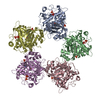
| ||||||||
|---|---|---|---|---|---|---|---|---|---|
| 1 | 
| ||||||||
| 2 | 
| ||||||||
| 3 | 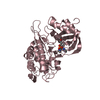
| ||||||||
| 4 | 
| ||||||||
| 5 | 
| ||||||||
| Unit cell |
|
- Components
Components
| #1: Protein | Mass: 38920.641 Da / Num. of mol.: 5 / Fragment: UNP residues 162-503, GS AND KINASE DOMAINS Source method: isolated from a genetically manipulated source Source: (gene. exp.)  Homo sapiens (human) / Gene: TGFBR1, TGFBRI / Production host: Homo sapiens (human) / Gene: TGFBR1, TGFBRI / Production host:  References: UniProt: P36897, receptor protein serine/threonine kinase #2: Chemical | ChemComp-JZO / #3: Chemical | ChemComp-PO4 / #4: Water | ChemComp-HOH / | |
|---|
-Experimental details
-Experiment
| Experiment | Method:  X-RAY DIFFRACTION / Number of used crystals: 1 X-RAY DIFFRACTION / Number of used crystals: 1 |
|---|
- Sample preparation
Sample preparation
| Crystal | Density Matthews: 3.84 Å3/Da / Density % sol: 67.99 % |
|---|---|
| Crystal grow | Temperature: 293 K / Method: vapor diffusion, hanging drop / pH: 7.4 Details: Sodium potassium phosphate, pH 7.4, VAPOR DIFFUSION, HANGING DROP, temperature 293K |
-Data collection
| Diffraction | Mean temperature: 100 K |
|---|---|
| Diffraction source | Source:  SYNCHROTRON / Site: SYNCHROTRON / Site:  NSLS NSLS  / Beamline: X25 / Wavelength: 1.1 Å / Beamline: X25 / Wavelength: 1.1 Å |
| Detector | Type: ADSC QUANTUM 315 / Detector: CCD / Date: Aug 1, 2005 / Details: monochromator |
| Radiation | Protocol: SINGLE WAVELENGTH / Monochromatic (M) / Laue (L): M / Scattering type: x-ray |
| Radiation wavelength | Wavelength: 1.1 Å / Relative weight: 1 |
| Reflection | Resolution: 2.8→50 Å / Num. all: 73727 / Num. obs: 73525 / % possible obs: 99.8 % / Observed criterion σ(F): 0 / Observed criterion σ(I): 2 / Redundancy: 4.4 % / Biso Wilson estimate: 52.9 Å2 / Rmerge(I) obs: 0.097 |
| Reflection shell | Resolution: 2.8→2.9 Å / Redundancy: 3.49 % / Rmerge(I) obs: 0.521 / Mean I/σ(I) obs: 2.15 / Num. unique all: 7240 / % possible all: 99.3 |
- Processing
Processing
| Software |
| ||||||||||||||||||||||||||||||||||||||||||||||||||||||||||||||||||||||||||||||||
|---|---|---|---|---|---|---|---|---|---|---|---|---|---|---|---|---|---|---|---|---|---|---|---|---|---|---|---|---|---|---|---|---|---|---|---|---|---|---|---|---|---|---|---|---|---|---|---|---|---|---|---|---|---|---|---|---|---|---|---|---|---|---|---|---|---|---|---|---|---|---|---|---|---|---|---|---|---|---|---|---|---|
| Refinement | Method to determine structure:  MOLECULAR REPLACEMENT MOLECULAR REPLACEMENTStarting model: Structure of TGFbRI with different inhibitor Resolution: 2.8→34.86 Å / Rfactor Rfree error: 0.005 / Data cutoff high absF: 3273596.81 / Data cutoff low absF: 0 / Isotropic thermal model: RESTRAINED / Cross valid method: THROUGHOUT / σ(F): 0 / Stereochemistry target values: Engh & Huber
| ||||||||||||||||||||||||||||||||||||||||||||||||||||||||||||||||||||||||||||||||
| Solvent computation | Solvent model: FLAT MODEL / Bsol: 41.4394 Å2 / ksol: 0.357103 e/Å3 | ||||||||||||||||||||||||||||||||||||||||||||||||||||||||||||||||||||||||||||||||
| Displacement parameters | Biso mean: 52.4 Å2
| ||||||||||||||||||||||||||||||||||||||||||||||||||||||||||||||||||||||||||||||||
| Refine analyze |
| ||||||||||||||||||||||||||||||||||||||||||||||||||||||||||||||||||||||||||||||||
| Refinement step | Cycle: LAST / Resolution: 2.8→34.86 Å
| ||||||||||||||||||||||||||||||||||||||||||||||||||||||||||||||||||||||||||||||||
| Refine LS restraints |
| ||||||||||||||||||||||||||||||||||||||||||||||||||||||||||||||||||||||||||||||||
| Refine LS restraints NCS | NCS model details: NONE | ||||||||||||||||||||||||||||||||||||||||||||||||||||||||||||||||||||||||||||||||
| LS refinement shell | Resolution: 2.8→2.98 Å / Rfactor Rfree error: 0.016 / Total num. of bins used: 6
| ||||||||||||||||||||||||||||||||||||||||||||||||||||||||||||||||||||||||||||||||
| Xplor file |
|
 Movie
Movie Controller
Controller


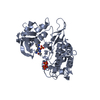


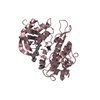
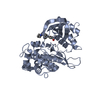

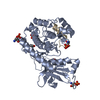
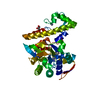
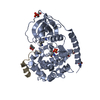
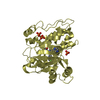
 PDBj
PDBj